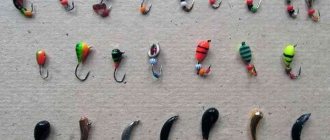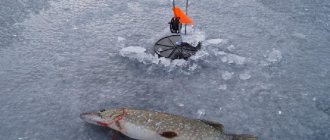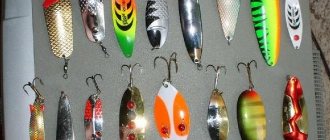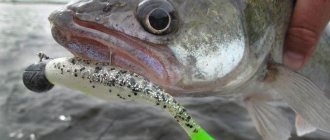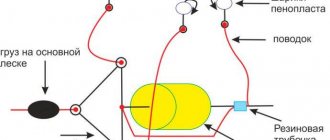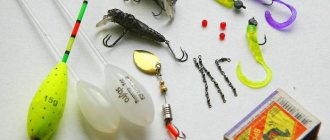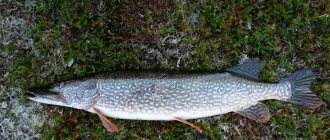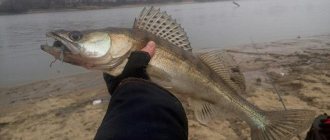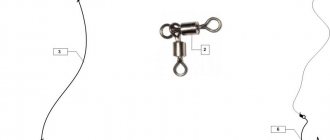Chekhon can be found in all large bodies of water with running water. It belongs to the carp family, and is distinguished by its omnivorous and biting activity. It can be caught using any tackle with a hook and bait. Before the start of spawning, saberfish gather in schools. During this period, it is caught with bottom gear, including with an elastic band . There is no point in explaining what an “elastic band” is, since this simple and effective tackle is familiar to every amateur fisherman. To fully understand the technique of using this gear, you need to know the behavior of saberfish.
What does the saberfish hunt for?
Chekhon is no exception and feeds throughout the year, like all cyprinids. Her diet may include:
- zoo- and phytoplankton;
- worms of various origins;
- larvae of many insects;
- insects directly;
- molluscs and crustaceans;
- fish fry.
Until the age of 3, the sabrefish is considered not a predatory fish, and after that it begins to chase the fry of various fish, turning into a predator. For normal life activities, saber fish feed both day and night, constantly migrating throughout the reservoir.
What time of year is best to catch saberfish?
So, with the help of a rubber donkey, you can catch sabrefish from mid-spring to mid-October. The best time to catch sabrefish is the pre-spawning period, as well as a week after the end of spawning.
The beginning of spawning in sabrefish depends on weather conditions; as a rule, in most regions of our country it is the end of May, but in the Lower Volga spawning occurs around mid-April. Before the start of spawning, saberfish gather in large schools and begin to actively feed. Therefore, mid-May is rightfully considered the most successful fishing time, when it is possible to catch more than 10 kg of fish in just a few hours.
During spawning, saberfish completely stop feeding, so you should not attempt to catch this fish until mid-June. It would be right to switch to catching other peaceful fish or predators for a while, for example, during the spawning of sabrefish; pike perch, pike, and perch will be great to catch.
Where to catch saberfish
Chekhon loves space and prefers open areas of the reservoir. You can find it:
- at the depth of reservoirs and rivers, in the presence of a current;
- in places where direct and reverse currents converge;
- deep-sea backwaters occupying small areas;
- in pits with a rocky bottom or a pile of driftwood;
- during spawning, these may be floodplains of rivers and lakes;
- on river rapids;
- at the depths of rivers and lakes not overgrown with algae.
When choosing a fishing spot, you should take into account what time of day and year. Like all fish, sabrefish bite best in the spring, before spawning. This period is celebrated in early May. When hungry, flocks of sabrefish rise closer to the surface in search of food and you can count on successful fishing. If you get into a flock, you can catch all the individuals, down to the last one. Being at some distance from the shore and not feeling any threat, the saberfish actively bites.
After laying eggs, the saberfish somewhat reduces its activity, but the bite does not stop until frost.
After a certain decrease in water temperature, saberfish go to depth, gathering in schools. At the same time, it can rise from the depths, especially during warming periods, to chase the fry.
Choosing a catchable fishing spot
Chekhon lives exclusively in open water.
Promising places for fishing for this aquatic inhabitant include:
- deep-sea areas of slow-flowing reservoirs;
- areas where the main and reverse currents intersect;
- backwaters with sufficient depth;
- sandy and rocky shallows;
- windows on the pond;
- river rapids.
It is necessary to select a particular area of a reservoir for fishing taking into account the seasonal and time factors. The most successful time for hunting saber fish is the spring months before the start of the spawning period.
It is in May, when the fish especially experience a strong feeling of hunger, that they rise to the surface in search of food. The catch is not only qualitative, but also quite quantitative.
The object of fishing, as a rule, stays away from the coastal zone, in clean areas of the reservoir (without algae), nothing scares it and the bite, if it has begun, will continue until the last individual from the flock. At the end of the spawn, the bite deteriorates somewhat, but not for long (about two weeks).
In summer you can fish at dawn, at sunset, and even at night. The activity of the fish is not at its best, but the bites are constant, and it does not change its usual stopping places.
With the onset of cold weather, in autumn, fishing is no less effective than in spring, but at the first frost, the predator gathers in flocks and descends to the depths to winter. When the weather improves, the target goes out to hunt for fry.
What does the saberfish bite on?
Since saberfish are omnivorous, they can be caught using any natural or artificial bait. These can be worms, live bait or vibrotails and twisters. Sometimes, she may covet a bare hook tied with colored thread. When catching this fish, the following baits are used:
- maggot;
- muckworm;
- various insects;
- larvae of various insects;
- fish fry.
And yet, maggot is considered the best bait. Maggots are fly larvae that attract sabrefish with their smell and are clearly visible at depth. In addition, you can catch several fish with one maggot. A dung worm is considered a universal bait, which is successfully used for catching this fish. In May, the emergence of various insects begins, which are part of the saberfish’s diet. Therefore, during this period, you should pay attention to the use of insects or their larvae as bait.
Chekhon can also be caught using live bait, but only in the autumn, when many insects are no longer there, and it needs to gain nutrients before wintering.
Methods of catching sabrefish
In fact, sabrefish can be caught by any means: with a float rod, bombard, elastic, feeder, donka, fly fishing.
Fishing with bombard (sbirulino)
When fishing with this method, it is important to consider the fishing location and select a sinking float. A bombard is a sinker strung on a fishing line with sinking baits
It is preferable to fish with a sinking bombard baited with fry, midges, and insects.
Fishing is successful in the summer in the morning or in the evening near rifts and slopes.
When choosing a bombard, you should pay attention to the equipment and select:
- rod up to 6 m in length;
- float weighing 50 g;
- inertial coil;
- braided fishing line up to 18 m in length, 20-25 mm in thickness;
- fluorocarbon leader up to 2 m long;
- swivel;
- sharp hooks No. 17-19.
Small suspenders will serve as wiring, which will move the tackle through the water when fishing with a bombard.
Bombard rig
Chekhon is careful, but bites on Sbirulino usually don’t take long to arrive. Even peaceful fish on the river can be caught well with a bombard, although it is not worth fishing from the shore with it.
On a float rod
When fishing with a float rod, you need to adhere to the tactics of fishing with saberfish. It is better to fish in the morning, when the fish begin to hunt for fry and midges on the water.
If small splashes appear, then we can assume that the place was chosen well and there are fish nearby. Suitable for maggots and worms. In this place it is worth playing with the fish, either throwing the tackle or lifting it up.
It is better to take biological bait for long-term retention on the surface of the water.
For fishing, a standard float rig with a rod length of 8-10 mm and a fishing line up to 0.18 mm in diameter is quite suitable. When using float gear, it is best to send it to float on its own with the current.
On the rubber donk
An elastic band is an easy tackle to use. This is a regular donk with a rubber shock absorber. It is good to catch crucian carp and saberfish.
Includes:
- reel wound around the tackle;
- fishing line 50 m long;
- leash up to 25 mm in diameter;
- carabiner with elastic swivel up to 1000 mm in length;
- sinker with 500-600 g of fishing line.
It is better to fish with an elastic band from a boat, and use fry, grasshoppers, maggots and worms as bait, periodically pulling the fishing line with hooks towards you to attract the attention of the fish at the moment of capture. When fishing with an elastic band, it is better to keep the tackle in the upper layers and make up to 8 knots on the line as boundaries beyond which the floats should not go
Non-slip float can be used
When fishing with an elastic band, it is better to keep the tackle in the upper layers and make up to 8 knots on the line as boundaries beyond which the floats should not go. You can use a non-slip float.
The technique of fishing with an elastic band is quite simple:
- throwing the tackle with a sinker and elastic band into the water so that the hooks are located in the right place;
- attaching the float and feeder to the tackle.
If the weather is cloudy, then it is better to lower the tackle closer to the bottom to 1.5 m. If it is clear, then leave it on the surface of the water, but check that there are no algae nearby, otherwise the activity of the fish will lead to snagging of the fishing line, and fishing will go down the drain.
To the feeder
When fishing with a feeder, it is important to consider:
- weather;
- current intensity in the selected area of the reservoir;
- feeder weight not exceeding 60 grams;
- speed of delivery of equipment to the right place.
Food should be supplied to the feeding area on time and without problems. When fishing on a sabrefish feeder, the tackle is somewhat different from the traditional one. The fish prefers to vibrate and go into the depths, so when catching it is necessary to increase the length of the leash to 2 m, and equip the fishing rod with foam balls to make catching easier. The length of the leash should be at least 18 mm, the feeder should be light in weight and slowly sink to the bottom when casting.
There is no need to compact the complementary foods in the feeders too much. In the water column it should be gradually and easily washed out.
Fly fishing
If you want to fly fish, you need to select a special cone-shaped rod. As bait - flies, streamers.
When fly fishing, you first need to get used to it and beginners cannot do it. Fly fishing for saberfish is rarely used because it is neither comfortable nor convenient.
The best tackle for sabrefish
This tackle is known to all fishermen and is called “rubber band”. In essence, it is a bottom tackle with a rubber shock absorber. Its convenience lies in the fact that you do not need to constantly pull the entire tackle out of the water, but only part of it where the hooks with the nozzle are located. At the same time, it is convenient to use, since you do not have to constantly throw it away. The fact is that the hooks, when released, themselves, under the action of the rubber shock absorber, go to depth. Unfortunately, it is only effective in areas where there are no algae.
“Gum” is used in the spring, pre-spawning period, when its activity is highest. Using such gear, you can catch a lot of sabrefish, but you should not take more than you can eat. As a rule, various fishing bans are in effect at this time. In addition, the “elastic band” is successfully used for catching roach, crucian carp, perch, silver bream, etc.
How to catch saberfish with an elastic band?
In order for the hunt to be a success, bottom tackle with a rubber shock absorber must be correctly installed in a promising fishing location.
To do this, you can use one of the following methods:
- Using a flotation device. Using a boat not only simplifies the selection of a promising place, but also makes it possible to cast a donk without unnecessary noise, so as not to frighten off a cautious predator. The length of the rubber shock absorber will determine the working distance; it can be calculated experimentally. Tackle with leashes and hooks must be brought to a specific distance and quietly lowered into the water.
- The cargo is thrown from the shore. It is important to take precautions here; leashes equipped with sharp hooks can injure your hands; it is better to disconnect them. To cast, the load must be held by the rope. Having completed the cast, the donkey must be removed from the water and the leashes attached to it, and the bait must be attached to them.
One of the features of saber fishing is that the working thread must always be in the fisherman’s hand in order to periodically tighten the equipment. The bite is instantly felt in the hand, it is similar to a hook, after which there are frequent jerks of the hooked prey.
When caught, a saber fish tries to immediately go against the current and spit out the hook. At one time, a tackle with a rubber shock absorber can catch from 2 to 3 pieces; when fishing, it is recommended to do everything carefully and confidently. This object offers strong resistance, you need to be prepared for it.
How to make an elastic band
Considering the fact that you won’t be able to buy it in a store, you’ll have to do it yourself. This is due to the fact that this tackle is not sporting. As a last resort, it can be purchased on the market, but the ease of manufacture allows you to make it yourself. This will require the following components:
- fishing line with a diameter of 0.3-0.5 mm and a length of 40-50 m;
- fishing line for leashes, diameter 0.25 mm;
- swivels for attaching leashes;
- aviation elastic, 15-25 m long;
- cargo weighing up to 1 kg;
- strong rope, up to 1 m long;
- hooks, 5-6 pieces No. 6-No. 8;
- winding rings or clasps;
- reel;
- bite alarm;
- float, if necessary.
A load weighing about 1 kg is tied to a strong rope, the length of which is approximately 1 m. Using this piece of rope, the “elastic band” is thrown into the pond. Loops are formed at the ends of the elastic, through which, as well as with the help of fasteners and winding rings, it is connected to the rope and the main fishing line.
After this, leashes are made from fishing line of the appropriate diameter. The length of the leashes can be in the range of 30-50 cm. A hook is attached to one end of the leash, and a loop is formed at the other end, to which a carabiner is attached.
Then, on the main line, at a distance of 50-70 cm from each other, loops are knitted. There should be as many of them as there are leashes. Leashes can be attached using carabiners or using the loop-to-loop method. After this, we can assume that the tackle is ready. If the leashes are attached using fasteners, then they can be installed after casting the tackle, which makes the process of casting and transportation easier. Leashes with hooks simply won’t be a hindrance, since they can be transported separately, secured to the leash.
Tackle Elastic band. A detailed description of its assembly from scratch.
Elastic band as the most productive tackle in catching saberfish
Chekhon is a fish that is a source of real adrenaline. Another popular name among fishermen is saber. She behaves so lively and frisky on the hook that the excitement of catching her simply goes off scale. Therefore, it is no secret to anyone that during periods of active and short-term fishing for sabrefish, most fishermen switch to catching this extraordinary species of fish. Catching sabrefish with an elastic band is the most effective way to catch it. In addition, this tackle is very popular among people because of its simplicity. A significant disadvantage of this gear is the lack of mobility. The rubber band is installed only in one promising place.
The river saber mainly lives in the lower reaches of large rivers, although there are sedentary individuals that live throughout the entire river. The further north you go, the density of this fish is much less and it is not entirely easy to catch it there. However, it mainly stays in deep places with strong currents. But the elastic band for fishing this fish is more applicable only in small places up to approximately 2-3 m. It is these places that schools of sabrefish prefer most for school hunting for their food. Therefore, in the lower reaches of rivers you can catch this fish with an elastic band throughout the warm period of the year. For all lovers of this exciting fish, the most long-awaited thing is the spring run of sabrefish. Starting in early spring, shoals of sabrefish move upstream to spawn. Depending on spring weather conditions, this period may fall at different times.
Rising over vast distances and ending up in many tributaries of large rivers, this fish mainly feeds on sand spits, underwater islands, riffles and other small places far from the shore. As a rule, such places are located on a large current. It is in such places that the rubber band needs to be installed. Depending on the weather, any fish caught can move to different layers of the reservoir. And saberfish are no exception - the warmer the weather, the higher the feeding level of sabrefish will be.
Photo 1. A quiet place on the river is ideal for fishing.
The rubber band is not a new tackle; it is very popular when fishing for crucian carp. In our area it has been used since the middle of the last century. The option for catching sabrefish is not much different from the crucian type rubber band. This gear contains the following components:
- First, let's choose a strong elastic band.
Photo 2. Rubber shock absorber.
When assembled, the elastic is a very compact tackle and usually easily fits into any fishing bag.
Photo 3. Assembled equipment on the reel.
Some fishermen use mesh bags for feeding when fishing for sabrefish. Most often they are attached to a buoy. You can use the option with a plastic bottle that contains small holes. As bait you can take barley porridge, millet and breadcrumbs. Moreover, you can feed in different layers of the reservoir:
- in the middle layer, geysers, that is, gas-forming substances, are added to the bait;
- in the surface layer you can use seed husks, coconut flakes, breadcrumbs, crushed popcorn;
- In the lowest layers of the reservoir, the saber fish does not feed due to its unique mouth structure.
A small selection of baits is used to catch sabrefish. In spring, live baits – worms and maggots – are widely used. But worms are much preferable.
What bait should I use?
Let's look at each type of bait separately:
- The best bait for catching sabrefish is maggot . Two or three maggots are conveniently strung on a hook, and they are enough for several bites. This bait attracts fish with its smell and contrasting appearance.
- Sometimes saberfish are amazing at worms . Any type of them is suitable: • dung; • underleaves. This universal bait perfectly attracts fish and can sometimes significantly improve the hunting result. You can’t let the worm’s tail hang from the hook, otherwise the saber fish will be able to pull it off.
- It is also possible to use plant baits : • mastyrka; • bread; • porridge. But, as a rule, they are not as effective as live ones.
- Closer to autumn, fry of various fish are good bait, so they can also be used for elastic fishing. They must be fresh and alive.
- During the pre-spawning period, there are situations when the best bait is red thread or goat hair tied to a hook.
- Sometimes hooking with a foam ball . It raises the bait in the water column, which will contribute to better bite of sabrefish. Typically, foam balls are made in different colors and coated with attractants.
The best time to fish with a rubber band
You can use a bottom fishing rod with a shock absorber from spring to late autumn. But the best time is the pre-spawning period. The mating season for saberfish occurs at the end of May. However, in different regions, depending on natural features, it may shift somewhat in one direction or another. It is before spawning that the fish gather in large “shoals”. If a large flock is located near an established donkey, then several tens of kilograms of sabrefish can be caught in a day. During mating games, the biting stops for a short time. But already at the beginning of summer you can again continue the fascinating process of fishing with an elastic band.
Reel fishing technique
The most difficult thing in fishing with an elastic band is casting the tackle. First you need to carefully lay it out on the bank downstream from you. Secure the end to the stand.
The safety line is attached to a peg driven near the water upstream. This is done to ensure that the main line does not overlap with the safety line. The safety line will be under tension, and the main line will be carried away by the current.
Holding the nylon cord, you need to forcefully swing the load and send it into the reservoir as far as possible. Immediately after this, you need to take out the slack on the safety line and re-fasten it to the peg.
After this, you can proceed to equipping the tackle. You need to pull the main fishing line towards you and secure it on a stand to make it more convenient to rig. Next, you should attach the leashes to the main fishing line using carabiners and attach a nozzle or bait to the hooks.
Having released the fishing line from the stand, you should smoothly release it so that the stretched shock absorber contracts and the leashes with hooks reach the place where the fish will be caught.
The sabrefish will not actively peck at a stationary tackle. To get a good bite, you need to constantly pull up and release the tackle, as if playing with it.
When biting, you need to pull the line to hook the fish, but then you need to lead it slowly, without jerking. It is advisable not to lift the saberfish above the surface of the water, so as not to tear its weak lips and prevent it from slipping off. When fishing, you also need to remember that sabrefish are quite playful fish and will try to drag the bait to the depths.
For a better bite, you can use bait. This will make it possible to both attract fish and keep them in this place. It is optimal to use small bait, which is fed from the surface of the water and sinks slowly.
